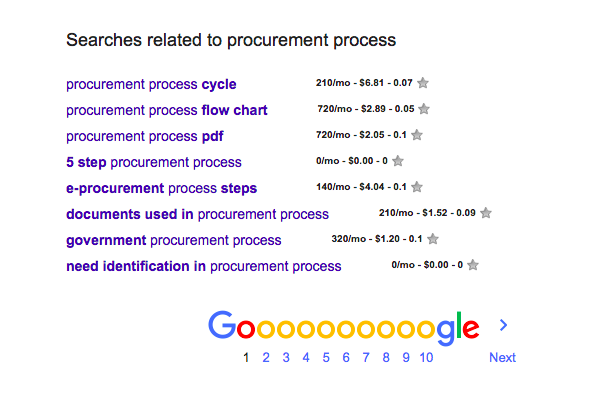When we launched Kissflow for procurement teams last fall, we faced the same problem every other SEO Analyst faces: how do we grow our organic visitors? The obvious answer was content.
We did the obvious things that every single “SEO Best Practices” blog talks about, but we knew it wasn’t enough. Generating quality content consistently and optimizing it for search engines can work wonders for your organic growth and you’ll see how exactly we went about that.
Hack 1:
Everyone loves a comprehensive article for one reason: you don’t have to move around to get all the information. Let’s take the keyword “procurement process” for example. It has an average monthly search volume of 14,800. It’s what we call a category keyword in the industry and it’s not as easy to get ranked on the first page.
The best way to put your page on Google’s radar, ahead of thousands of other pages and get to the first page is by covering all related topics to the one at hand. You can easily find these topics at the end of the SERP. These are called LSI keywords. You can also use a chrome extension like Keywords Everywhere or Answerthepublic to find related topics.

By being comprehensive, you tell the search engines that your page has all the information your readers possibly look for.
Hack 2: Content Is King. And, So Is Intent.
Let’s take the same example as before. What do you think is the intent of the people searching for “procurement process”? Mostly they are trying to find more information about the process. Now consider the keyword “purchase order system”. The intent could be either purchasing a PO system (transactional) or to know more about a PO system (informational).
When the intent is transactional, a landing page works best. It makes total sense, right? You tell them your USP, the features of your product, pricing, and more. The catch is that landing pages are light on content and search engines prefer content-heavy pages (See point 4 for details).
When faced with this conundrum, we decided, as an experiment, to write a long-form blog that still satisfies the intent while playing nice with Google’s algorithms. We wrote a piece about setting up a purchase order system. We waited for a couple of weeks before the page started showing promising results. After analyzing user behavioral patterns, we optimized the page and guess where it’s ranking now.
Hack 3: Content at Its Peak of Freshness.
One thing that worked in our favor was that most sites that ranked for “procurement processes” had really outdated content; they were so outdated that they were last updated three years ago. We knew it was important to make sure our content was fresh and up to date so it could outrank other pages easily.

We addressed the same topics from a fresh line of thinking, filled with the latest industry trends and reports. Et voila! Most of the target keywords started ranking in the top three results almost immediately. Like magic.
Hack 4: Make It Long Enough to Count.
With decreasing attention spans and smaller screens, it’s reasonable to think that short-form articles work better. But, search engines prefer longer forms of content and for good reason. The longer your content the more value readers derive from it. We read a few reports that said the top ten results in the SERP had an average of 2000+ words. So we decided to give it a try.

We created a content strategy for all our pages to add immense value and substantial information. We also made sure our pages did not miss out on any information that other competitors offer.
We shot for the 1200-1500 word count in most blogs while being careful not to barrage the readers with inane, insipid, and irrelevant content. This was a line we had to tread carefully because it’s difficult to hold someone’s attention for a longer duration.
Longer articles mean readers stay on your page much longer (dwell time) and this increases the chance of them signing up for your newsletter or visiting your website. The length and depth of the articles helped us earn a lot of backlinks and also gave us the opportunity for exhaustive internal link building.
We found that the average time spent on the page was just under two minutes for a 5-minute read. This was disconcerting at first. We looked at scroll maps and attention span reports and found something interesting.



High attention was spread across the page indicating that even though people were not reading the entire article, they were deriving value out of it, at least in pieces. This revelation shattered one of the myths we’ve been clinging on to–you don’t need the reader’s complete attention for the page to add value.
Closing Thoughts
SEO is often seen as a Google appeasement tactic; you’re rewarded if you do it right and you’re penalized if you do it wrong. The last few months taught us that there’s ample scope for experimentation and drawing conclusions from data-driven analyses. Follow the best SEO practices, continuously evaluate and optimize your content, and add genuine value to your readers and you’ll see your organic traffic soaring.
After all, getting from 340 to 10,000 new users a month was a distant dream for us once.












